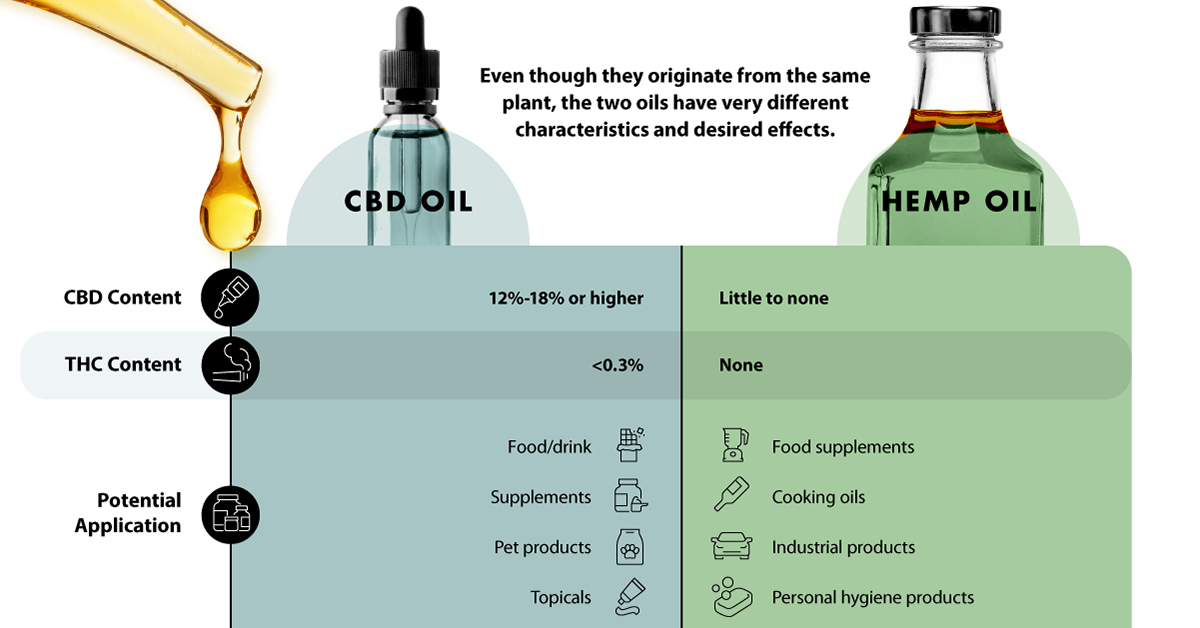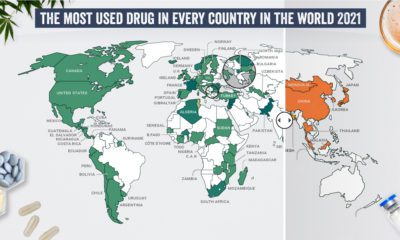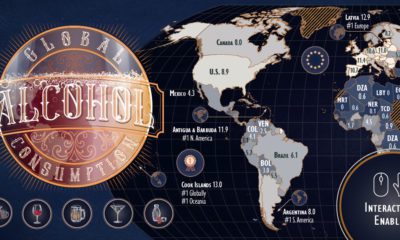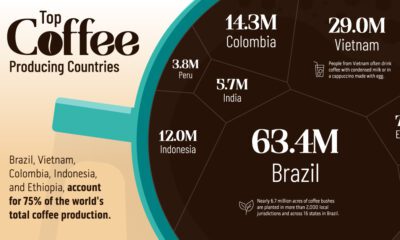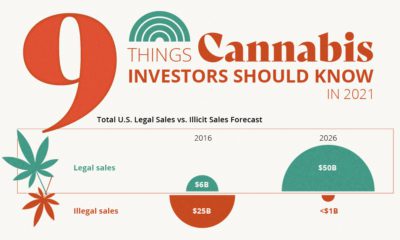Cannabis
CBD Oil vs. Hemp Oil: What’s the Difference?
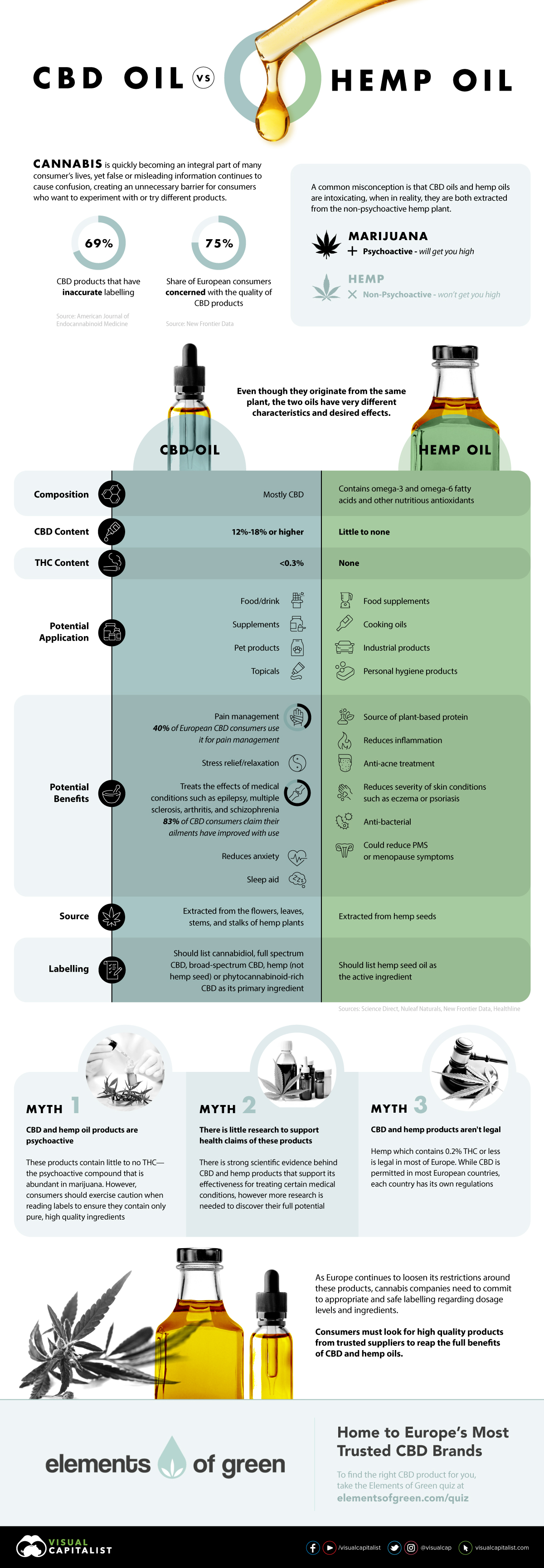
CBD Oil vs. Hemp Oil: What’s the Difference?
For many consumers, cannabis plays a significant role in the treatment of medical conditions and managing general well-being. As a result, certain products have seen a rapid increase in popularity in recent years.
But while awareness of these products is at an all-time high, false or misleading information continues to cause confusion, and creates an unnecessary barrier for consumers who want to experiment with, or try different products.
For example, 69% of cannabidiol (CBD) products are reported to have inaccurate labeling, so it’s no surprise that some consumers are uncertain about the suitability of these products and are hesitant to invest.
Today’s graphic from Elements of Green dives into the differences between popular cannabis products, CBD oil and hemp seed oil—more commonly known as hemp oil— and the common misconceptions that are inhibiting consumers from entering the space en masse.
Same Plant, Difference Characteristics
Typically, both CBD oil and hemp oil originate from the hemp plant, a non-psychoactive cannabis plant. Therefore, it typically does not result in any intoxicating effects. However, many consumers mistakenly believe that CBD or hemp products will get them high, when in fact it is the marijuana plant—hemp’s psychoactive cousin—that can induce mind-altering effects.
Even though both oils are extracted from the same plant, they each have very different characteristics and uses that consumers should be aware of.
CBD Oil
CBD oil is extracted from the flowers, leaves, stems, and stalks of hemp plants, and contains high levels of the naturally occurring CBD compound. Various CBD oil formats include tinctures, vape oil, and capsules, which are commonly used for their proven therapeutic benefits, such as:
- Pain management
- Relaxation
- Stress relief
- Treatment of medical conditions such as epilepsy, schizophrenia, multiple sclerosis, and arthritis
- Reduction in anxiety
- Sleep aid
When it comes to product labeling, consumers should be aware that different types of CBD oils exist, depending on the chemical compounds—known as cannabinoids—they contain.
- CBD Isolate: Pure CBD, with no other cannabinoids such as THC
- Full-spectrum CBD oil: Contains CBD among other cannabinoids, including THC
- Broad-spectrum CBD oil: Contains CBD among other cannabinoids, with no THC
These oils are used in a wide variety of consumer products such as beverages, beauty products, and even pet food.
Hemp Oil
Hemp oil, on the other hand, is extracted from hemp seeds and contains no cannabinoids such as CBD and THC. It is used more like a traditional cooking oil, but can also be found in topical creams and lotions.
More recently, hemp oil is being hailed for its use in industrial products such as concrete, bio-plastics and fuel. While it has huge potential for use in both consumer and industrial products, its benefits differ slightly to CBD oil:
- Source of plant-based protein and rich in fatty acids and antioxidants
- Reduces inflammation
- Reduces severity of skin conditions such as acne, eczema, or psoriasis
- Anti-bacterial properties
- Could reduce PMS or menopause symptoms
Consumers should ensure that hemp oil is listed as the active ingredient on the product’s packaging, but it may also be listed as cannabis sativa seed oil.
Busting the Myths
While there is strong scientific evidence to support the efficacy of CBD oil and hemp oil, companies need to commit to both appropriate and safe labeling regarding dosage levels and ingredients.
Following that, previously held stigmas and misconceptions should slowly disintegrate as these products become more widely available and consumers increase their knowledge and understanding of their benefits.
Considering that the popularity of cannabis consumer products has only exploded over the last decade, initial confusion surrounding them is to be expected, and the true potential of these products is yet to be realised.
Politics
Timeline: Cannabis Legislation in the U.S.
At the federal level, cannabis is illegal, but state laws differ. This graphic looks at the timelines of cannabis legislation in the U.S.
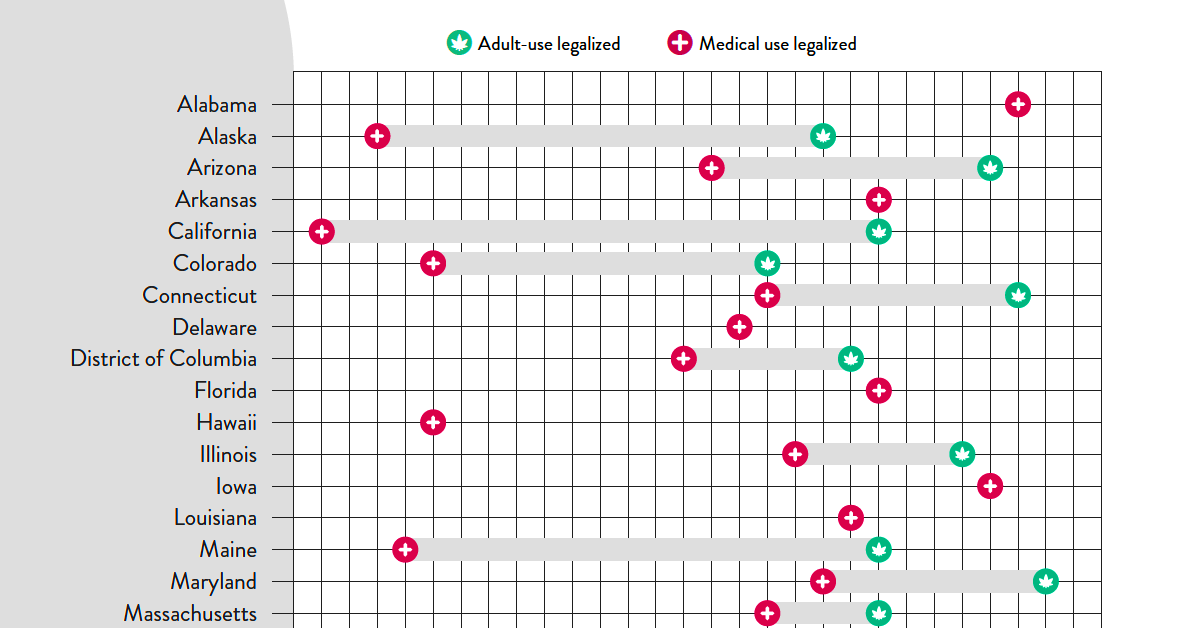
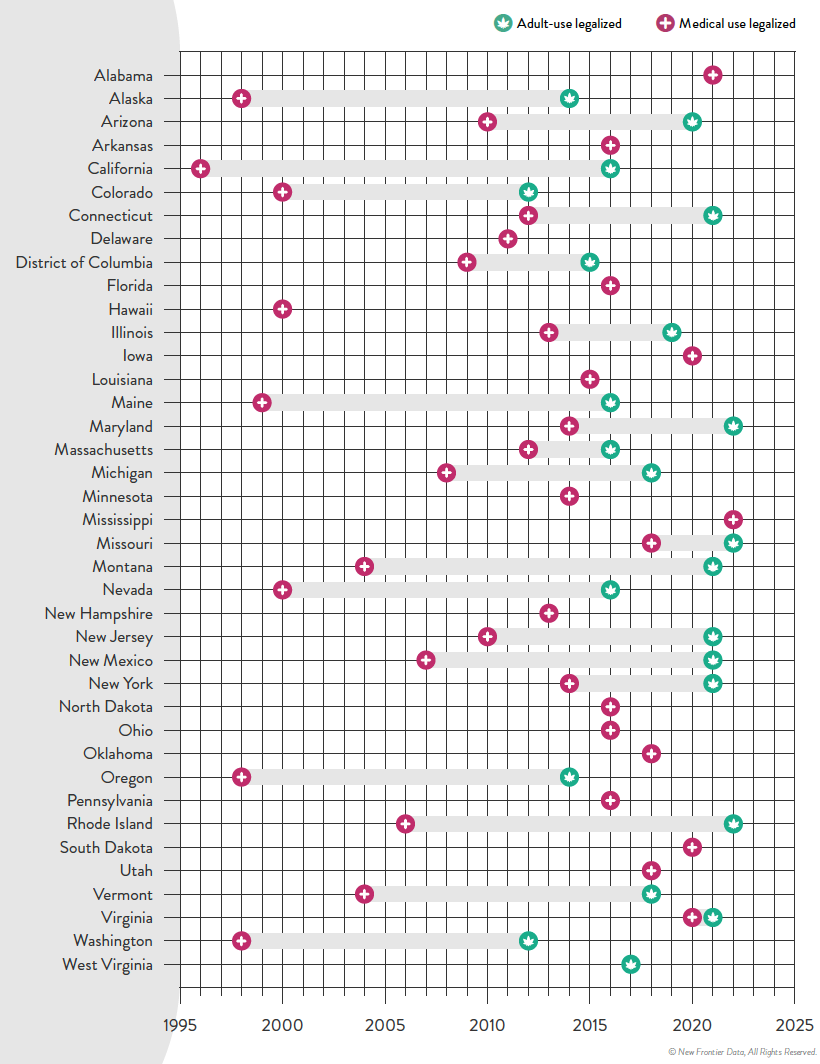
Timeline: Cannabis Legislation in the U.S.
At the federal level, cannabis is still considered an illegal substance. That said, individual states do have the right to determine their own laws around cannabis sales and usage.
This visual from New Frontier Data looks at the status of cannabis in every state and the timeline of when medical and/or recreational use became legal.
Cannabis Through the Years
In the U.S., the oldest legalese concerning cannabis dates back to the 1600s—the colony of Virginia required every farm to grow and produce hemp. Since then, cannabis use was fairly wide open until the 1930s when the Marihuana Tax Act was enforced, prohibiting marijuana federally but still technically allowing medical use.
Jumping ahead, the Controlled Substances Act was passed in 1970, classifying cannabis as Schedule I drug—the same category as heroin. This prohibited any use of the substance.
However, the 1970s also saw a counter movement, wherein many states made the move towards decriminalization. Decriminalization means that although possessing cannabis remained illegal, a person would not be subject to jail time or prosecution for possessing certain amounts.
By the 1990s, some of the first states passed laws to allow the medical usage of cannabis, and by 2012 two states in the U.S.—Washington and Colorado—legalized the recreational use of cannabis.
Cannabis Legislation Today and Beyond
The MORE Act (the Marijuana Opportunity Reinvestment and Expungement Act) was passed in the House early 2022, and if made law, it would decriminalize marijuana federally.
“This bill decriminalizes marijuana. Specifically, it removes marijuana from the list of scheduled substances under the Controlled Substances Act and eliminates criminal penalties for an individual who manufactures, distributes, or possesses marijuana.”– U.S. Congress
Cannabis still remains illegal at the federal level, but at the state levels, cannabis is now fully legal (both for medicinal and recreational purposes) in a total of 22 states.
Over 246 million Americans have legal access to some form of marijuana products with high THC levels. Looking to the future, many new cannabis markets are expected to open up in the next few years:
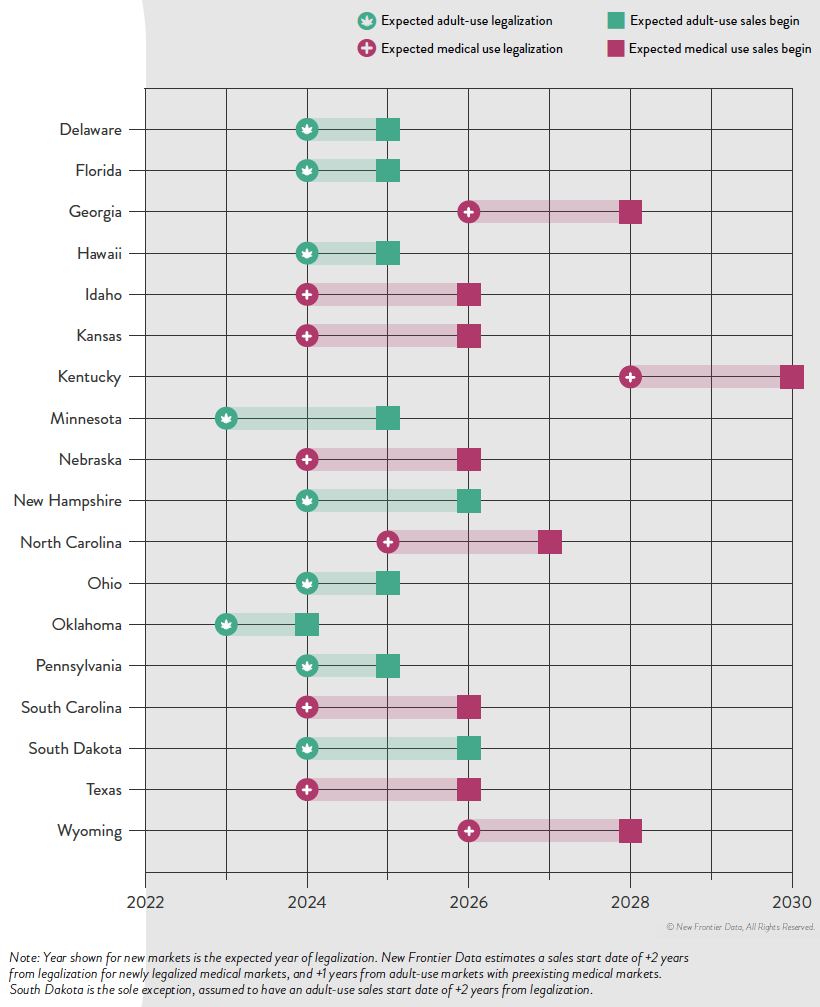
The earliest states expected to open up next for recreational cannabis sales are Minnesota and Oklahoma. There is always a lag between legalization and actual sales, wherein local regulatory bodies and governments set standards. States like Kentucky, on the other hand, aren’t likely to even legalize medicinal cannabis until 2028.
It’s estimated that by 2030, there will be 69 million cannabis consumers in the country, up 33% from 2022.
Overall, the U.S. cannabis market is likely an important one to watch as legal sales hit $30 billion in 2022. By the end of the decade, that number is expected to be anywhere from $58 billion to as much as $72 billion.
-

 Science1 week ago
Science1 week agoVisualizing the Average Lifespans of Mammals
-

 Markets2 weeks ago
Markets2 weeks agoThe Top 10 States by Real GDP Growth in 2023
-

 Demographics2 weeks ago
Demographics2 weeks agoThe Smallest Gender Wage Gaps in OECD Countries
-

 United States2 weeks ago
United States2 weeks agoWhere U.S. Inflation Hit the Hardest in March 2024
-

 Green2 weeks ago
Green2 weeks agoTop Countries By Forest Growth Since 2001
-

 United States2 weeks ago
United States2 weeks agoRanked: The Largest U.S. Corporations by Number of Employees
-

 Maps2 weeks ago
Maps2 weeks agoThe Largest Earthquakes in the New York Area (1970-2024)
-

 Green2 weeks ago
Green2 weeks agoRanked: The Countries With the Most Air Pollution in 2023

